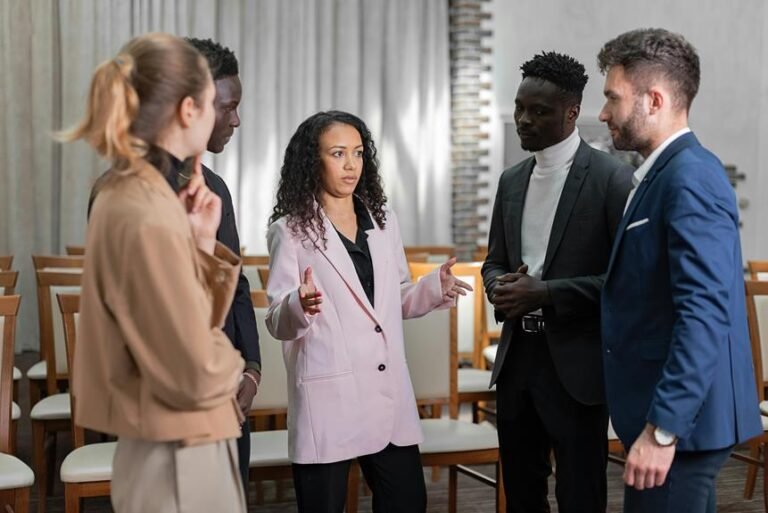Building Trust Through Communication

To build trust through communication, focus on nonverbal cues and tone of voice, key in conveying 93% of effectiveness. Active listening and clear communication are essential for fostering strong relationships. Authenticity and vulnerability create a safe space for understanding. Strategies like maintaining eye contact and asking clarifying questions enhance your listening skills. Handling difficult conversations with openness and empathy is important for conflict resolution. Consistent transparency and honest communication sustain trust over time. Trust-building demands dedication and effort. Mastering these elements lays the groundwork for successful relationships and collaborations.
Key Takeaways
- Active listening fosters understanding and shows genuine interest.
- Nonverbal cues like body language impact trust in communication.
- Clear and straightforward language enhances trust.
- Building rapport through shared experiences and emotions creates trust.
- Finding common ground forms the foundation of trust in relationships.
Importance of Trust in Communication
Building trust in communication is vital for fostering strong relationships and effective collaboration. Trust dynamics play a fundamental role in how we connect with others, impacting the depth and quality of our interactions.
When trust is established as a solid communication foundation, it creates a safe space for open dialogue, vulnerability, and understanding.
In any relationship, whether personal or professional, trust dynamics shape the way we communicate and interact with one another. It sets the tone for how comfortable individuals feel sharing their thoughts, feelings, and ideas.
Without trust, communication can become strained, leading to misunderstandings, conflicts, and a breakdown in relationships.
Elements of Effective Communication
Establishing trust in communication hinges on mastering the key elements of effective interaction. One key element is active listening, where you fully engage with the speaker, showing genuine interest in their words. Through active listening, you demonstrate respect and understanding, fostering a deeper connection and trust.
Nonverbal cues play a significant role in communication. Your body language, facial expressions, and eye contact all convey messages that can either enhance or detract from trust. Being aware of your nonverbal cues and ensuring they align with your verbal communication is essential in building trust.
Effective communication also involves being clear and concise in your messages. Avoid ambiguity and use language that's easily understood. By being straightforward, you establish transparency and credibility in your interactions.
Incorporating these elements of active listening, attention to nonverbal cues, and clarity in communication will help you build trust and strengthen your relationships through effective communication.
Building Rapport and Connection
To foster strong relationships, focus on connecting authentically with others through open and genuine communication. Active engagement is key in establishing rapport. Show genuine interest in the other person by actively listening, asking thoughtful questions, and being present in the moment. Share your own experiences and emotions to create a sense of vulnerability and build trust.
Building rapport requires more than just exchanging pleasantries; it involves truly connecting on a deeper level. Find common ground, whether it's a shared interest, a similar experience, or a mutual goal. This shared connection forms the foundation of a strong relationship.
Strategies for Clear Communication
Enhance your communication effectiveness by incorporating specific strategies that promote clarity and understanding in your interactions with others. Active listening is a key component in clear communication. When engaging in conversation, focus on the speaker, maintain eye contact, and show that you're fully present by nodding or providing verbal cues. By actively listening, you demonstrate respect and interest in what the other person is saying, fostering a deeper connection and understanding.
Nonverbal cues play a significant role in communication. Pay attention to body language, facial expressions, and tone of voice to better interpret the message being conveyed. Likewise, be mindful of your own nonverbal cues to confirm they align with your words, avoiding any conflicting signals that may lead to misunderstandings.
Enhancing Listening Skills
Improve your listening skills by actively engaging in conversations and demonstrating genuine interest in what others have to say. Active listening involves more than just hearing words; it requires focus, empathy, and understanding.
To enhance your communication techniques, start by maintaining eye contact, nodding to show you're following along, and providing verbal cues like 'I see' or 'That makes sense.' These actions affirm the speaker and encourage them to share openly.
Another effective strategy is to ask clarifying questions to guarantee you grasp the speaker's message accurately. Reflecting on what was said by paraphrasing it back demonstrates your attentiveness and helps avoid misunderstandings.
Additionally, practice patience and avoid interrupting, allowing the speaker to express themselves fully.
Navigating Difficult Conversations
When facing difficult conversations, it's vital to approach them with an open mind and a willingness to listen actively. Conflict resolution often begins with active listening. This means focusing not just on the words being spoken but also on the emotions and intentions behind them. It's crucial to create a safe space for open dialogue where both parties feel heard and understood.
During challenging discussions, remember that communication is a two-way street. Be attentive to verbal and non-verbal cues to grasp the full message. Acknowledge the other person's feelings and perspectives even if you don't agree with them.
Avoid getting defensive or escalating the tension. Instead, aim to find common ground and work towards a resolution together.
Cultivating Empathy and Understanding
Fostering empathy and understanding is key in building strong interpersonal relationships. To deepen your connections, engaging in empathy exercises can be transformative. By actively listening to others' perspectives without judgment, you create a safe space for open dialogue. Communication workshops offer valuable tools to enhance your empathetic abilities. Through these workshops, you can learn how to communicate effectively, validate emotions, and show genuine interest in others' experiences.
Practicing empathy involves putting yourself in someone else's shoes, acknowledging their feelings, and responding with compassion. It's about being present in the moment and showing that you care. These skills can be honed through guided exercises that challenge you to see the world through different lenses. By actively participating in communication workshops, you not only improve your empathetic understanding but also strengthen your overall communication skills.
Incorporating empathy exercises into your daily interactions and committing to ongoing learning in communication workshops will unquestionably enrich your relationships and foster deeper connections based on understanding and compassion.
Sustaining Trust in Relationships
To maintain trust in your relationships, consistent and transparent communication is crucial. Trust-building is a long-term endeavor that requires ongoing effort and dedication.
Honesty is the cornerstone of sustaining trust in your relationships. It's vital to be open and sincere in your interactions to nurture a strong foundation of trust.
Effective communication plays a pivotal role in maintaining trust. Regularly check in with your partner, family member, or friend to make sure that you're on the same page. Listen actively and attentively to their concerns, thoughts, and feelings. Respond thoughtfully and empathetically to show that you value their perspective.
In the journey of sustaining trust, remember that actions speak louder than words. Be reliable and consistent in your behavior to demonstrate your commitment to the relationship. Uphold your promises and follow through on your commitments to build credibility and trust over time.
Frequently Asked Questions
How Do Personal Biases Affect Communication Trust?
Your unconscious biases can influence communication trust. Stereotypes may hinder trust-building efforts. It's essential to recognize and address these biases to foster genuine connections and establish a strong foundation of trust in your interactions.
Can Technology Hinder Trust-Building Efforts?
When you rely solely on digital communication, trust-building efforts may be hindered by communication barriers and misunderstandings. It's important to balance technology with face-to-face interactions to overcome trust issues effectively.
What Role Does Body Language Play in Trust?
Body language, those subtle nonverbal cues, speaks volumes in trust-building. Your gestures, eye contact, and posture convey sincerity and reliability, shaping others' perception of your trustworthiness even more than your words alone.
How Can Cultural Differences Impact Trust in Communication?
Cultural differences can impact trust in communication through language barriers leading to misinterpretation. Stereotyping and making assumptions based on cultural norms can hinder understanding and create distrust. Embrace diversity to build stronger connections.
Is Humor an Effective Tool for Building Trust?
Humor can be a powerful tool for building trust when used with vulnerability. Timing and appropriateness are key. Sharing light-hearted moments can foster connection, but be mindful of boundaries to guarantee your humor resonates positively.
Conclusion
To sum up, trust is the cornerstone of effective communication. By prioritizing building rapport, enhancing listening skills, and managing challenging conversations with empathy, you can enhance relationships and nurture trust.
Clear communication is crucial in establishing comprehension and rapport. Implement these strategies to nurture trust in your interactions and maintain healthy relationships.
Keep in mind, communication is a mutual process that necessitates dedication and receptiveness to genuinely foster trust.






